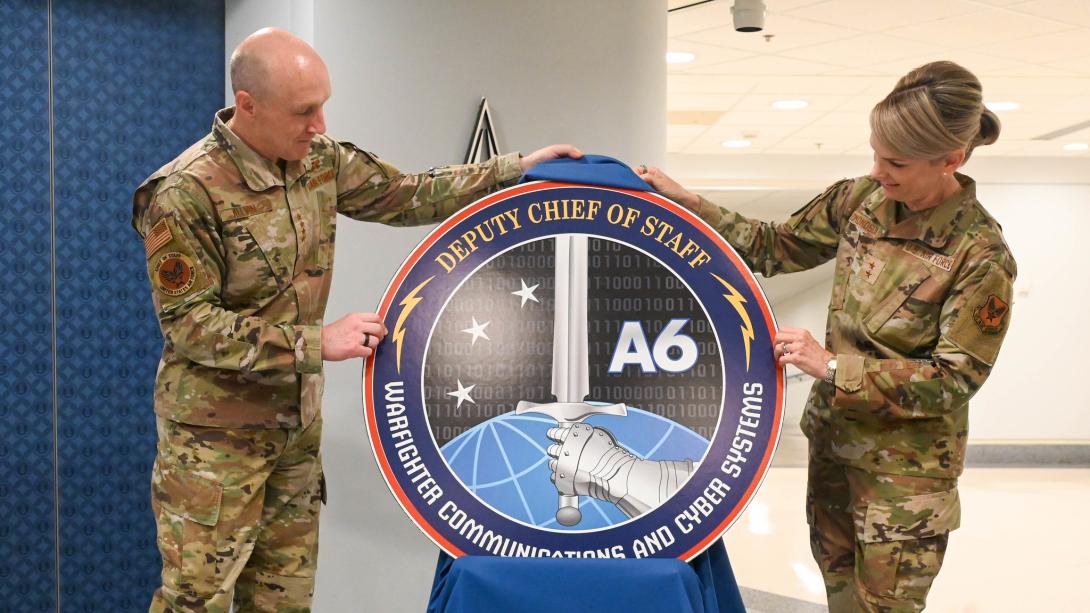New Air Force A6 Role Is Established
On July 23, the Department of the Air Force (DAF) celebrated the establishment of the Air Force A6, creating the Deputy Chief of Staff for Warfighter Communications and Cyber Systems and related office within the DAF.
The creation of the Air Force A6 office separates the responsibilities for communications and cyber systems from the previous A2/6 framework, a Department of the Air Force spokesperson noted.
DAF officials spent the last two years working to stand up the office.
“[This] marks one of the most significant reorganizations of the Air Staff in over 30 years,” the spokesperson told SIGNAL Media.
The change is designed to improve readiness, resilience and operational effectiveness by aligning resources and risk management with mission requirements, within one office.
“The A6 will be organized around a warfighter-centric model, designed to support current capabilities while informing future investment decisions and force design initiatives,” the spokesperson stated.
Having the central Air Force A6 will allow the new office to focus not only on representing warfighter communications and cyber systems at the Air Staff level and joint interactions, but also guide the A6 leaders from across the service’s major commands—such as the Air Combat Command’s A6, Communications Directorate, Brig. Gen. Jeffrey Phillips—on down to the A6s on the wing staffs.
Maj. Gen. Michele Edmondson, USAF, stepped into the new Air Force A6 position during the July 23 ceremony.
“Our mission is to ensure warfighters have the reliable, secure communications they need to succeed—whether in competition or conflict,” Edmondson said. “We’re building an enterprise that connects people, systems and decisions at the speed required by today’s operational demands.”
The Air Force’s top military leader applauded the move.
“We created the A6 to ensure communications and cyber systems are available, secure and aligned with warfighter priorities,” said Gen. David Allvin, Air Force chief of staff. “This office will help us focus resources and oversight where it matters most—supporting the mission in contested environments.”
This is especially important as the Air Force transitions to having its unit of action be on the wing level, as part of the service’s reoptimization efforts.
Deputy Chief of Staff for Intelligence Lt. Gen. Leah Lauderback, who had been the A2/6, the deputy chief of staff for intelligence, surveillance, reconnaissance and cyber effects operations, emphasized that “standing up the A6 allows us to manage risk, prioritize limited resources and advocate for warfighter needs using data from across the enterprise.”
Lauderback’s role continues as the A2, focusing solely on intelligence.
AFCEA’s Vice President for Defense Col. Michael Black, USAF (Ret.), explained to SIGNAL Media that the stand-up of the A6 office elevates the voice of the communications and cyber professionals whose mission includes securing communications, delivering resilient networks and guaranteeing command and control connectivity and interoperability, which are all foundational to joint and combined all-domain operations and warfighter lethality and readiness.
It was a necessary move, Black said, one that represents much more than a symbolic patch swap out or alphanumeric restructuring of the Air Staff. It is a strategic milestone, he emphasized.
“As a 26-year Air Force communications and cyber officer, I view this as an overdue action that brings clarity, unity and dedicated Deputy Chief of Staff-level, focused advocacy to one of the most operationally critical mission areas in the Department of the Air Force,” Black stated. “I commend this bold step forward and encourage continued investment in the people and technology, as well as government, industry and academia collaboration that will define and ensure information superiority in the years ahead.”
This step builds on another big move by the Air Force, the successful return of warrant officers to the service. In a swift, year-long effort, officials reestablished the position to bring technical expertise right to commanders and units at the operational level.
“It’s a necessary step to treat communications and cyber as the operational enablers they are,” Lauderback noted.




Comments